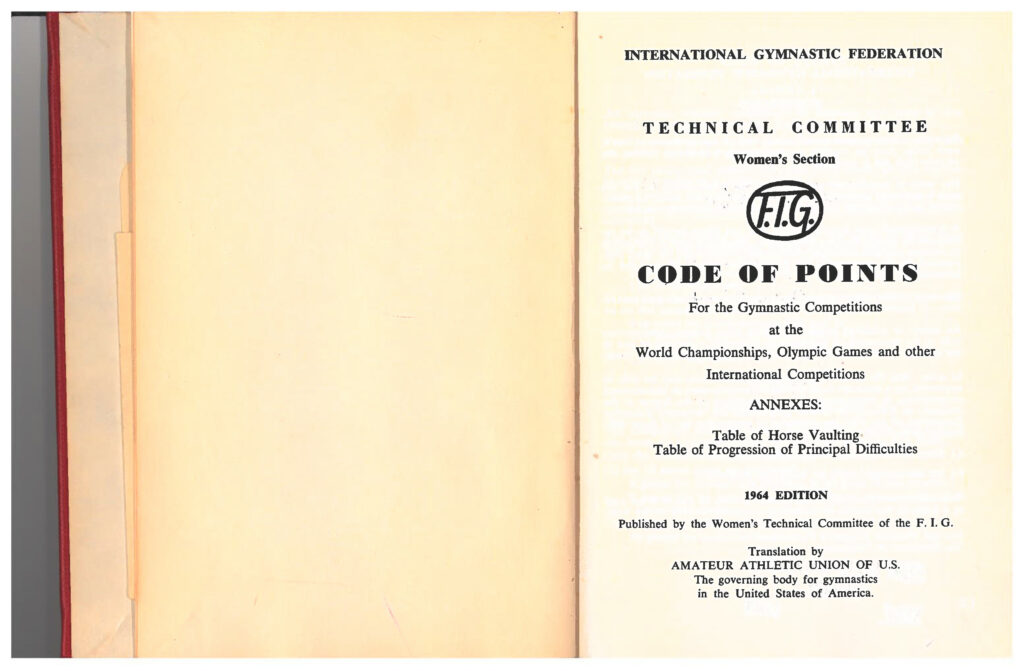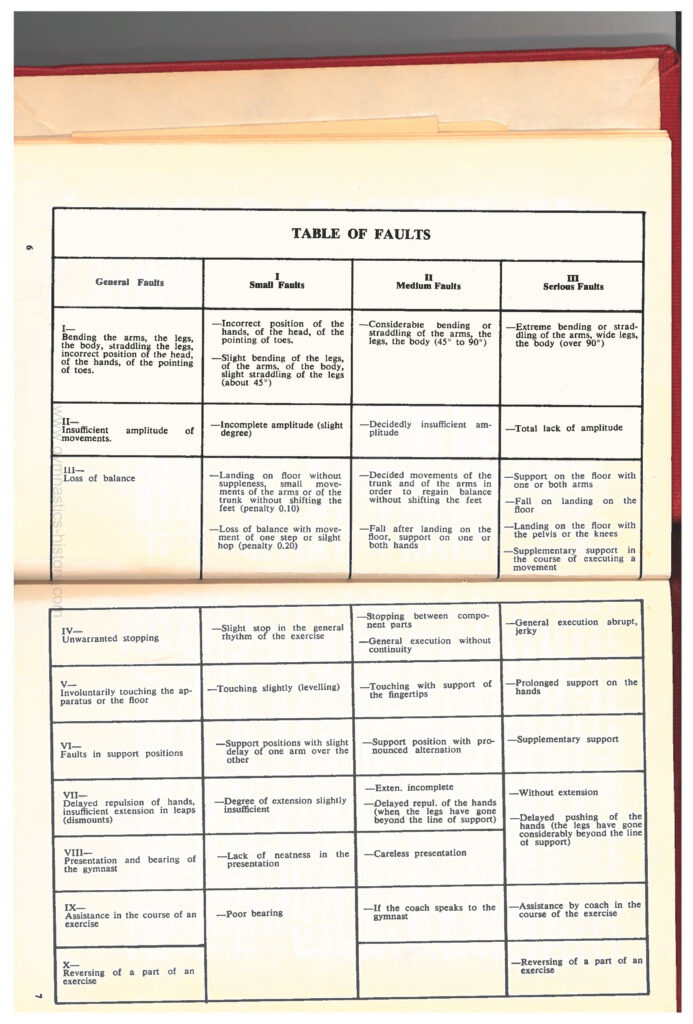The 1964 Code of Points was the second Code for women’s gymnastics. You can read the document in its entirety at the bottom of this post. Otherwise, here are a few notes…

Compulsory Routines
- 5 points for rhythm and precision
- 5 points for the general impression (i.e. elegance and assurance of execution)
- Gymnasts could repeat their compulsory routines except in the case of floor exercise.
The judging was rather complicated. See the 1966 compulsory routines for more info.
Optional Routines
- 3 points for difficulty
- 5 elements of difficulty were required.
- 1 of those elements had to be of superior difficulty.
- It was not recommended to exceed that level of difficulty:
- “For the sake of general beauty of movement, and in order to avoid any regrettable excesses, it is expressly recommended not to exceed this level.”
- For each element missing, a 0.60 deduction.
- If no difficulty was included, a penalty of 3.0 was to be considered.
- 2 points for the composition (sequences) and the value of the general value of the sequences
- 5 points for execution and general impression
Deductions
- Small faults: 0.1 to 0.2
- Medium faults: 0.3 to 0.5
- Serious faults: 0.6+
Here’s the table of general deductions. (Each apparatus had its own set of deductions, as well.)

Vault
- Two vaults for optionals and compulsories
- For optionals, the two vaults could be different.
- Gymnasts could get a supplementary attempt as long as the gymnast did not touch the horse.
- Gymnasts could take a step or a hop upon landing as long as it was in the direction of the flight and wasn’t the result of unbalance. (This rule was also in the women’s 1968 Code of Points.)
Uneven Bars
- Falls
- 1.0 deduction
- 30 seconds to remount the bars
- Note: The men also had a 1.0 deduction for falls in 1964.
- Swinging was supposed to predominate. But…
- Stops were allowed: “Stops must be penalized except, when it is evident that they are necessary, either for position of balance or as a brief period fo concentration prior to some difficult passage.”
- As were balancing movements: “Balancing movements are permitted on condition that they be characteristic of the bars.”
- Each unjustified stop was a 0.20 deduction.
- My thought bubble: Those were rather subjective criteria. Did all judges have the same understanding of when a stop was allowed or what was considered to be “characteristic of the bars?”
Balance Beam
- Duration: 1:20 to 1:45
- The clock started when the gymnasts’ feet left the floor.
- The clock ended when the gymnasts’ feet touched the floor.
- Falls
- Unlike on bars, which allowed 30 seconds, gymnasts had 10 seconds to remount the beam.
- 1 point deduction for falling to the floor and falling on the beam
- Composition
- “Lively, make use of all parts of the body, contain steps, running, jump, turns”
- Maximum of 3 held positions
- Note: There was no explicit requirement to perform acrobatics.
- Though, to meet the difficulty requirements, most gymnasts performed acrobatics.
- In 1966, for example, both Kuchinskaya and Čáslavská performed back walkovers.
- Execution
- “Avoid monotony of rhythm and mark the held positions.”
- “The exercise shall be carried out with amplitude, confidence, suppleness, and with elegance.”
Floor Exercise
- Composition Requirements
- “Make use of the entire body, contain artistic movements and leaps with vitality, with poses, with balances, with change of pace, with expression.”
- Note: Again, there was no specific requirement for acrobatics. (Though, gymnasts had to perform acrobatics to meet the difficulty requirements.)
- Note #2: This phrasing borrows heavily from the wording for men’s floor exercise at the 1948 Olympics.
- “Make use of the entire body, contain artistic movements and leaps with vitality, with poses, with balances, with change of pace, with expression.”
- Duration: 1:00 to 1:30
- Accompaniment
- Only a single instrument could be used.
- “Must be closely connected with the composition, give it more vitality, aid in the relaxing part, underline the harmony of the movements, the elegance, and the personality of the performer; in short, provide the impetus needed for a more perfect artistic execution.”
Judging
- 5 judges
- The high and low scores were dropped; the remaining 3 were averaged.
- The President of the Jury (i.e. the President of the Women’s Technical Committee) had the final say: “The President of the Jury may intervene at any moment in the course of the competition in order ot observe and, if necessary, to correct the judges.
Note: The allowances between the three middle scores were updated in the 1964 Code of Points.
- In the 1958 Code of Points, the scores for the middle three judges could differ by 0.50 points for scores above 8.50.
- For example, a spread of 9.0, 9.2, and a 9.5 was permissible.
- Their scores could differ by 1.0 in all other cases.
- For example, a spread of 7.0, 7.5, and 8.0 was permissible.
Reuther Boards
- The 1964 Code of Points allowed for the use of Reuther boards for women’s competition.
- At the 1960 Olympics, the gymnasts had to use a “tremplin dur.”
- For more information on the evolution of the springboard, jump over here.
Download the 1964 Code of Points for Women’s Gymnastics
More on 1964